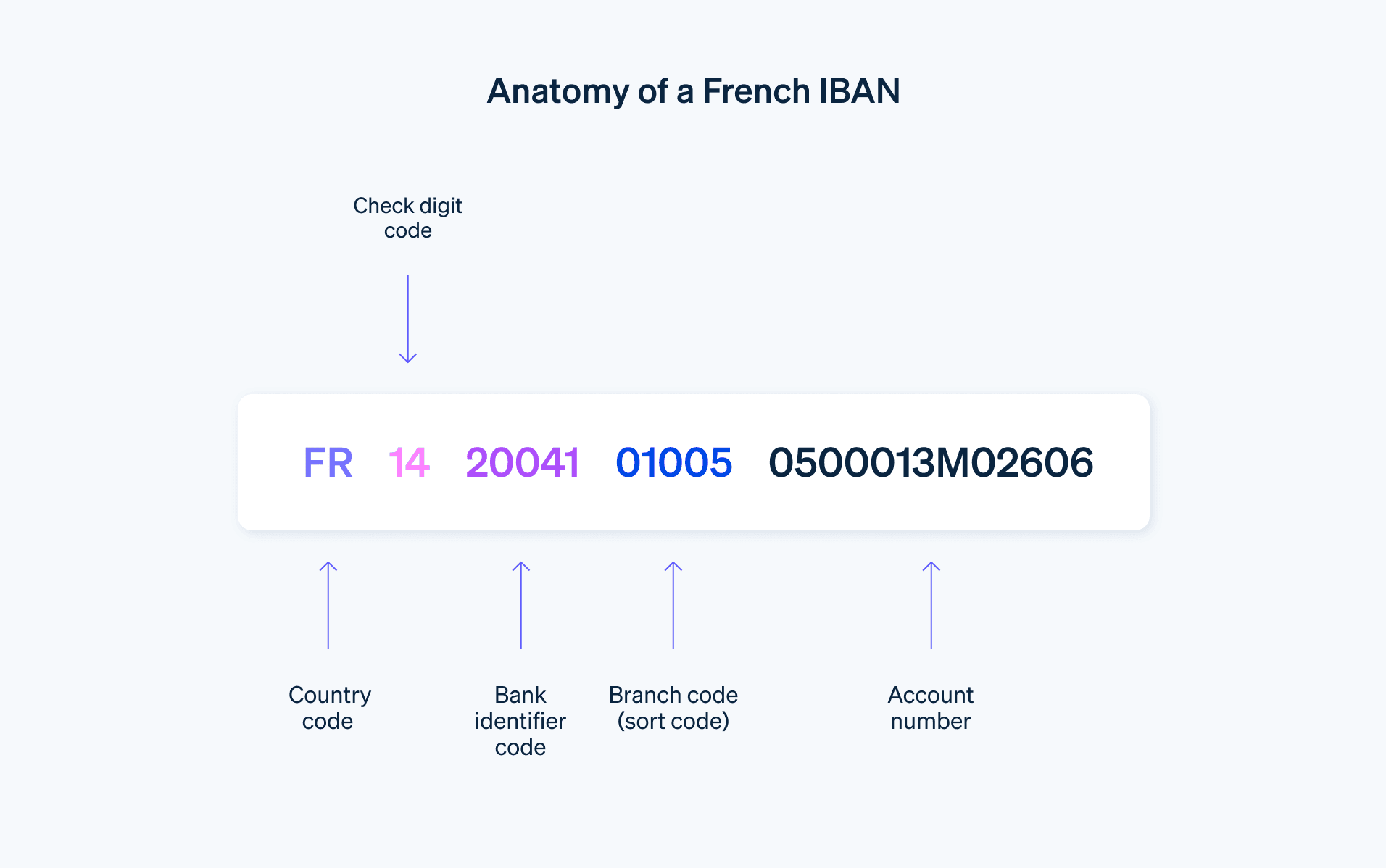IBAN 是确保在欧洲及海外实现资金安全转账的关键。但 IBAN 究竟是什么,如何找到它,其中的字母和数字又有什么含义?本文将解释您需要了解的一切,包括如何识别您的 IBAN。
本文内容
- 什么是 IBAN?
- IBAN 有什么用?
- IBAN 是如何形成的?
- 外国 IBAN 有多少个字母和数字?
- 在哪里可以找到您的 IBAN?
- 如何识别 IBAN 来自哪家银行?
什么是 IBAN?
IBAN 坐标、IBAN 代码、IBAN 密钥等术语都指代同一件事物:标准化的国际银行账号——一个字母数字代码,可用于识别世界各地的银行账户。IBAN 的首字母缩写代表“国际银行账户号码”。
IBAN 有什么用?
如果您想发送或接收国内或国际提现款项,了解您的 IBAN 非常重要。如果您想在法国境内或境外接收提现款项,您需要向付款方发送您的 IBAN 密钥。同样,如果您要向收款人发送提现款项,也需要收款人的 IBAN。
这些代码通常在单一欧元支付区 (SEPA) 内使用。SEPA 是一个独特的欧元支付区,由欧盟 27 个国家/地区以及瑞士、列支敦士登、挪威、摩纳哥、圣马力诺、安道尔和梵蒂冈组成。另请注意,英国在 2020 年脱离欧盟后仍是 SEPA 的成员。SEPA 内的所有国家/地区都使用 IBAN。
IBAN 是如何形成的?
在法国,IBAN 的格式为整整 27 个字符。前两个字母对应银行账户的国家/地区代码。在法国,国家/地区代码为“FR”(在德国,国家/地区代码为“DE”,而英国则为“GB”)。通过查看每个代码的前两个首字母,您可以确定 IBAN 的签发国家/地区。
国家代码后面的两个数字对应于与银行账户关联的校验密钥。该校验码对 IBAN 校验非常重要。
接下来的 23 位数字是银行基本账户号码 (BBAN),该号码由银行代码、路由号码、银行账号以及银行账户详情(法语为“relevé d’identité bancaire”或 RIB)组成。
法国的银行代码由五位数字组成。路径号码长度相同。
银行账号通常为 11 位数。对于较短的账户号码,会在号码开头加上零,将其填满至 11 位数。
IBAN 的末尾是 RIB 密钥,这是一个两位数的代码,用于确认银行账户是否确实有效。
法国 IBAN 示例
FR76 3000 4028 3798 7654 3210 943
在上述示例中,国家代码是“FR”,校验密钥是“76”,银行代码是“30004”,路径号码是“02837”,银行账号是“98765432109”,RIB 密钥是“43”。

外国 IBAN 有多少个字母和数字?
请注意,每个国家/地区的 IBAN 结构略有不同。大多数外国 IBAN 由 14 至 34 个字符组成。例如:德国 IBAN 为 DE89 3704 0044 0532 0130 00,英国 IBAN 为 GB29 NWBK 6016 1331 9268 19。
在哪里可以找到您的 IBAN?
查找 IBAN 的最简单方法是查看您的银行账户对账单或 RIB。您可以在银行账户的客户专区、支票簿在线查找 RIB,或前往银行柜台或银行 ATM 查找。另一种方法是使用在线 IBAN 计算器,根据您提供的信息(银行、账户号码等)生成您的 IBAN。
请务必仔细输入 IBAN:如果相关银行账户详情不存在,则输入错误的 IBAN 会导致交易无效;如果银行账户详情存在,但并非预期收款人的银行账户详情,则会将您的提现款项发送给错误的收款人。如果出现这种情况,您应尽快联系银行取消相关交易。
如何识别 IBAN 来自哪家银行?
了解 IBAN 的一般格式及其组成部分对于识别对应的银行至关重要。您可以通过查看校验码后面的字符,轻松找出 IBAN 对应的银行。这些字符共同组成银行代码,用于识别与相关 IBAN 相对应的银行机构。
有些银行代码仅由数字组成,而有些则包含字母。这些代码的长度和组成因国家/地区而异。例如,德国 IBAN 示例中的银行代码由八位数字组成,而英国 IBAN 示例中的银行代码由四个字母组成。法国 IBAN 示例“FR76 3000 4028 3798 7654 3210 943”中的银行代码“30004”对应的是法国巴黎银行。
以下是法国最新的银行代码:
- 巴黎银行 (BNP Paribas): 30004
- 法国农业信贷银行 (Crédit Agricole): 30006
- 法国兴业银行 (Société Générale): 30003
- 法国人民银行 (BPCE): 10107
- 法国储蓄银行 (BPCE): 11315
- 法国互助信贷银行 (Crédit Mutuel): 10278
- 法国邮政银行 (La Banque Postale): 20041
- 法国汇丰银行 (HSBC France): 30056
- 法国北方信贷银行 (Crédit du Nord): 30076
- 法国合作信贷银行 (Crédit Coopératif): 42559
本文中的内容仅供一般信息和教育目的,不应被解释为法律或税务建议。Stripe 不保证或担保文章中信息的准确性、完整性、充分性或时效性。您应该寻求在您的司法管辖区获得执业许可的合格律师或会计师的建议,以就您的特定情况提供建议。